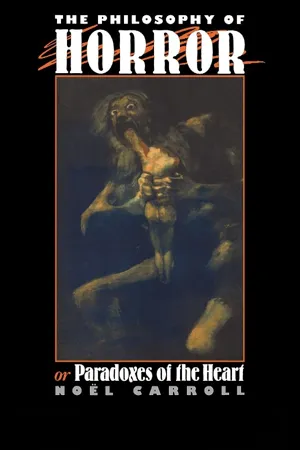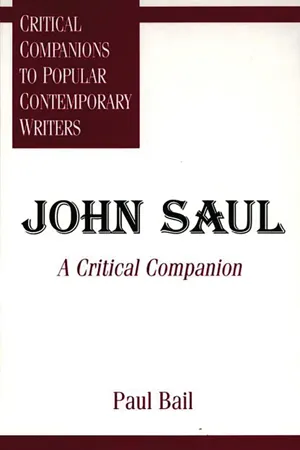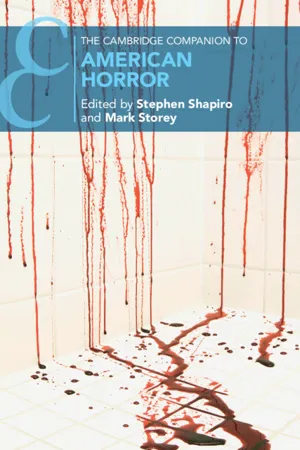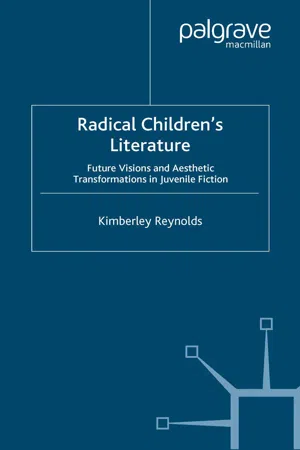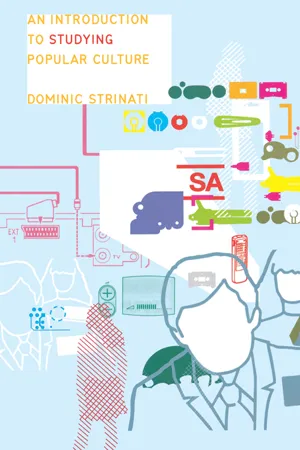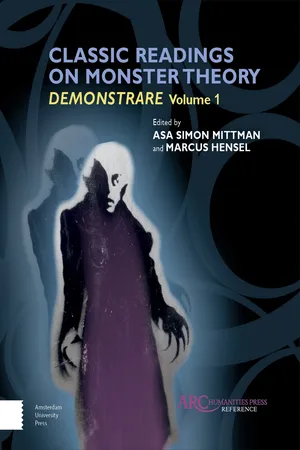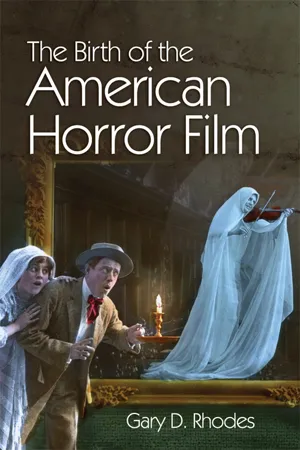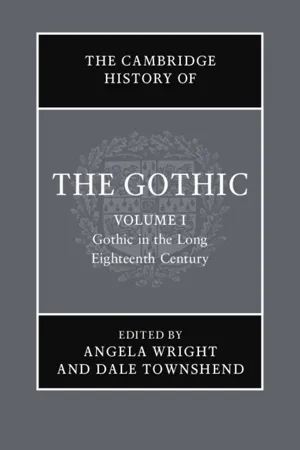Literature
Horror Novel
A horror novel is a literary genre that aims to evoke fear, terror, and suspense in readers. It often features supernatural elements, psychological horror, or gruesome and macabre themes. Horror novels can explore the darker aspects of human nature and often use suspenseful storytelling to create a sense of unease and dread in the reader.
Written by Perlego with AI-assistance
Related key terms
1 of 5
9 Key excerpts on "Horror Novel"
- eBook - ePub
The Philosophy of Horror
Or, Paradoxes of the Heart
- Noel Carroll(Author)
- 2003(Publication Date)
- Routledge(Publisher)
1 The Nature of Horror
The Definition of Horror
Preliminaries
The purpose of this book is to develop a theory of horror, which is conceived to be a genre that crosses numerous artforms and media. The type of horror to be explored here is that associated with reading something like Mary Shelley’s Frankenstein, Algernon Blackwood’s “Ancient Sorceries,” Robert Louis Stevenson’s The Strange Case of Dr. Jekyll and Mr. Hyde, H.P. Lovecraft’s “The Dunwich Horror,” Stephen King’s Pet Sematary, or Clive Barker’s Damnation Game; and it is also associated with seeing something like the Hamilton Deane and John Balderston stage version of Dracula, movies such as James Whale’s Bride of Frankenstein, Ridley Scott’s Alien, and George Romero’s Dawn of the Dead, ballets like Michael Uthoff s version of Coppelia, and operas/musicals like Andrew Lloyd Webber’s Phantom of the Opera. The relevant sort of horror can also be found in fine art, as in the work of Goya or H.R.Giger, in radio programs such as the Inner Sanctum and Suspense of yesteryear, and in TV series like Night Stalker, or Tales from the Darkside. We shall call this “art-horror.” Generally when the word “horror” is used in what follows, it should be understood as art-horror.This kind of horror is different from the sort that one expresses in saying “I am horrified by the prospect of ecological disaster,” or “Brinksmanship in the age of nuclear arms is horrifying,” or “What the Nazis did was horrible.” Call the latter usage of “horror,” natural horror. It is not the task of this book to analyze natural horror, but only art-horror, that is, “horror” as it serves to name a cross-art, cross-media genre whose existence is already recognized in ordinary language. This is the sense of the term “horror” that occurs when, for example, in answer to the question “What kind of book is The Shining?,” we say a horror story; or when we find programs are advertised in the TV Guide as “halloween horror shows” or when the blurb on Diana Henstell’s New Morning Dragon - The Horror Genre Take almost any deviation from customary experience, stretch it far enough, and you produce horror. Kirk J. Schneider, Horror and the Holy (1993) Horror is an emotion. It is also a genre of writing. Many authors are not happy with the name "horror." In fact, the speciality association Horror Writers of America almost changed its name in 1992. Various alternate labels for the genre include tales of terror, supernatural fiction, macabre tales, dark fantasy, fright fiction, the chiller (as a variant of the thriller), and weird tales—the name associated with the genre in the 1930s. The objection of some authors is that "horror" suggests a purely visceral reaction, whereas their writing aims at something higher than this. Ste- phen King, however, sums it up this way in Danse Macabre: [T]he genre exists on three more or less separate levels, each one a little less fine than the one before it .... My own phi- losophy ... is to recognize these distinctions because they are sometimes useful, but to avoid any preference for one over the other on the grounds that one effect is somehow better. ... I recognize terror as the finest emotion ... and so I will try to terrorize the reader. But if I find I cannot... I will try to 2 16 John Saul horrify; and if I find I cannot horrify, I'll go for the gross-out. I'm not proud. (1979, 36-37) Regardless of what we call it, though, it is clear that there is a recog- nizable body of work that appeals to a segment of the public. Despite a dip in the fortunes of the horror genre in the past decade, the abiding popularity of Gothicism and the supernatural is demonstrated by the fact that half of the twelve mass-market paperbacks that sold over two million copies in 1994 were by authors associated with the horror field: Anne Rice, Stephen King, V. C. Andrews, and Dean Koontz. And this popularity shows no signs of fading soon.
- eBook - PDF
- Stephen Shapiro, Mark Storey(Authors)
- 2022(Publication Date)
- Cambridge University Press(Publisher)
Our first impulse is to admit fuzziness and acknowledge that genre categories are never so distinctive as to make works easily shoehorned into one classification rather than another. Indeed, these definitions often say more about the assumptions of the moment in which they are made than they do about the works contained within them. The authors of the essays in this collection use both terms, and often make no clear distinction between “Gothic” and “horror” texts. But let us venture a definition, some steps toward what “horror” might be and a reclaiming of sorts from Radcliffe’s and critical history’s sniffy dismissal. Any number of definitions of Gothic could be cited here as a counterpoint, but Fred Botting, one of the field’s most distinguished critics, usefully summarizes it as a literature “depicting disturbances of sanity and security, from superstitious belief in ghosts and demons, displays of uncontrolled passion, violent emotion or flights of fancy to portrayals of perversion and obsession” (2). Similarly but even more pithily, Jeffrey Weinstock claims that “Gothic is a genre that focuses on the past and immoderate, ungovernable passions” (1). These are good places to start, especially because they open up a gap that, we suggest, horror fills. If, then, Gothic has tended to be associated with interior psychological states, uncanny forces, and – crucially – a Eurocentric history of aristocratic and religious residues and iconography, we suggest that horror points us to a more historically immediate and materially present form of experience. If Gothic’s collision of strange environment and dress with psychological fugue and paranoia often tracks the persistence of the past, we see horror as the name of something more corporeal and modern-facing. If Gothic emphasizes the “terror” of anticipation, then horror highlights the moment of pain and shock. - Rick Dakan, Ryan G. Van Cleave(Authors)
- 2022(Publication Date)
- For Dummies(Publisher)
5 Horror: Journeys into Fear IN THIS PART . . . Find emotional connections to make stories that haunt your audiences’ imagination. Trust well-trod shadowy paths to shape your own scary stories. Brew up monsters from archetypes and terrifying creatures you already know (and love). Make monsters a manifestation of fear, symbols, and themes in society. Use setting to build the imagery, mood, and atmosphere of dread. CHAPTER 18 Creating Dread, Fear, and Terror 255 Chapter 18 Creating Dread, Fear, and Terror I n this chapter, we dive deep into the spooky spectrum of thoughts and feelings that horror stories play with. For the pure horror story writers out there, we offer a tomb-load of tips and techniques for terrifying your audience. But this horror chapter plays very well with the sections about sci-fi and fantasy, and we occasionally refer you to specific chapters (such as Chapter 11 on aliens and 17 on fantasy monsters) for more ideas about incorporating the otherworldly and futur-istic into your horror fiction. Sci-fi stories are about people in other possible worlds and fantasy stories are about people in impossible other worlds. Horror stories are about scaring the @#!% out of people in any world. Horror stories aren’t a genre so much as a set of feelings like dread, fear, pity, and revulsion, sometimes all at once. The source of those fears may be some science thing gone wrong, some ancient magical thing unleashed, or a “normal” person with a hankering for hunting humans. Where sci-fi and fantasy provoke questions and play with ideas, horror goes straight for the primal, disturbing feelings deep inside everyone. IN THIS CHAPTER » Making the worst things happen (to your characters) » Creating horrible emotions » Revealing the narrative sources of dread and terror 256 PART 5 Horror: Journeys into Fear Imagining the Worst about Everything Fear is a powerful emotion.- eBook - PDF
Radical Children's Literature
Future Visions and Aesthetic Transformations in Juvenile Fiction
- K. Reynolds(Author)
- 2007(Publication Date)
- Palgrave Macmillan(Publisher)
Stories that use fear to promote change usually take the form of genres such as horror, thrillers, and mysteries: narratives that make the certain uncertain and in the process point to emotional and social cracks and fissures just below the surface of everyday reality, both individual and collective. Fictions of this sort generally achieve their effects by striving to expose the everyday as false and inadequate; often this means calling into question the inten- tions of those in authority. In the case of children’s literature, this usually involves disturbing the adult-child power dynamic, the stability of which Jacqueline Rose claims is a central tenet of children’s literature. With this in mind, it is perhaps surprising that frightening fiction is one of the largest and most diverse areas of writing for children. Coercion and conformity: the early history of frightening fiction Fear can be produced in readers in a number of ways, to different degrees and effects, and for a number of purposes. Many of the oldest and most enduring kinds of narratives produced for children – such things as rhymes, games, folk and fairy tales, and even lullabies – contain violent incidents, frightening situations, and a variety of threats directed at children. The threats may take the form of injury, abduction, punishment or death. Babies fall from tree tops, children fall down hills, are beaten and sent to bed, or abandoned in the wood. Such tales are staple nursery fare, even when they do not at first sight appear to feature children. Look, for instance, at the nursery rhyme (n.d.) about the ‘man of double deed’ who ‘Sowed his garden full of seed’ (Opie: 286). - eBook - ePub
- Dominic Strinati(Author)
- 2014(Publication Date)
- Routledge(Publisher)
The narrative order of the popular horror film tends, in outline, to conform to that of the typical Hollywood film. This appears to apply whatever the theory held about horror and whatever the historical period at issue. Of course, emphases may differ and some endings may be more ambiguous than others. However, the order, disorder, restoration of order narrative remains the pattern that is followed. With the horror film, social order is disrupted by a monster who is usually, but not always, nonhuman or inhuman. This monster normally engages in murder and mayhem. It threatens the community by killing people in gruesome ways which are far from normal and which take on supernatural and incomprehensible qualities that characterise the monster itself. Eventually, usually through the acquisition of knowledge that can comprehend and combat the monster, the monster is confronted and killed. Since it is a monster from the supernatural world, this need not prevent it from returning for a sequel or two. Quite often the issue or dispute in the literature seems to concern how this narrative order is to be interpreted. Is it, for example, repressive or progressive? This type of question may arise because the horror film has attracted more theoretical attention than the gangster film and it will emerge again below when relevant.These points will thus be returned to in the subsequent discussion. First, we shall consider how horror can be defined. Here, questions will be raised about what the horror film genre consists of, how it has been understood and how it relates to ideas about realism and to similar genres, such as science fiction. Second, we shall look at the cycles that have been said to characterise the history of the genre. This historical survey will indicate how the horror film genre, like all genres, has to be understood as a product of the Hollywood system. Finally, we shall consider some theories of horror which have tried to account for the significance, popularity and influence of the genre. This will necessarily draw upon the historical outline of the genre.Definitions of horrorAttempts to define horror rest to some extent upon the arguments of which they form a part. For example, the horror film will be defined as a genre that represents the need for suppression if the horror shown is interpreted as expressing uncomfortable and disturbing desires which need to be contained. The best way to define horror would be to use the changing definitions with which the film industry tries to sell its products and audiences try to make sense of their consumption. Systematic evidence of this sort, however, is not available and a relatively independent set of criteria may still be needed to analyse the horror genre. - eBook - PDF
Classic Readings on Monster Theory
Demonstrare, Volume One
- Asa Simon Mittman, Marcus Hensel, Asa Simon Mittman, Marcus Hensel(Authors)
- 2018(Publication Date)
- Arc Humanities Press(Publisher)
“The NaTure of horror,” from The PhilosoPhy of horror 29 mean that we believe in the existence of fictional monsters, as the characters in horror stories do, but that we regard the description or depiction of them as unsettling virtue of the same kind of qualities that revolt someone like Jonathan Harker in the preceding quotation. The emotional reactions of characters, then, provide a set of instructions or, rather, examples about the way in which the audience is to respond to the monsters in the fiction— that is, about the way we are meant to react to its monstrous properties. In the classic film King Kong, for example, there is a scene on the ship during the journey to Skull Island in which the fictional director, Carl Denham, stages a screen test for Ann Darrow, the heroine of the film within the film. The offscreen motivations that Denham supplies his starlet can be taken as a set of instructions for the way both Ann Darrow and the audience are to react to the first apparition of Kong. Denham says to Darrow: Now you look higher. You’re amazed. Your eyes open wider. It’s horrible Ann, but you can’t look away. There’s no chance for you, Ann—no escape. You’re helpless, Ann, helpless. There’s just one chance. If you can scream—but your throat’s paralyzed. Scream, Ann, cry. Perhaps if you didn’t see it you could scream. Throw your arms across your face and scream, scream for your life. In horror fictions, the emotions of the audience are supposed to mirror those of the positive human characters in certain, but not all, respects. In the preceding examples the characters’ responses counsel us that the appropriate reactions to the monsters in question comprise shuddering, nausea, shrink ing, paralysis, screaming, and revulsion. Our responses are meant, ideally, to parallel those of characters. - eBook - PDF
- Gary D. Rhodes(Author)
- 2018(Publication Date)
- Edinburgh University Press(Publisher)
The primary technique of sensationalism was body-horror, the effort to arouse the readers’ repugnance (and excitement) in the face of the physiological realities of violent death. 37 Such popular murder literature, which constituted a “new pornography of pain and vio-lence,” represented something of a reaction to the changing views on death in the nine-teenth century. 38 Halttunen adds, “Reading horror literature thus helped reinforce the rising levels of repression demanded by the growing humanitarian sanctions against vio-lent impulses and actions.” 39 An emphasis on murder did not mean the era was devoid of supernatural tales. For example, Clarence Day’s Remarkable Apparitions, and Ghost Stories was published in Phila-delphia in 1842. 40 His purpose was to offer “authentic histories of communications” with the “unseen world,” which included illustrated stories of “spectral warnings, haunted houses and places, extraordinary prophecies, aerial visions, etc.” All that said, Day appropriately qualified matters on the title page by describing the stories as either “real or imaginary.” LITERATURE 27 The stories were collected from “authentic sources,” in other words, even if their contents were hardly authentic. A similar anthology, Carey and Hart’s Ghost Stories: Collected with a Particular View to Counteract the Vulgar Belief in Ghosts and Apparitions (1846), ostensibly denied the supernatural while collecting tales about it. The American Gothic novel continued as well, as is evident in George Lippard’s very popular The Quaker City; or, the Monks of Monk Hall: A Romance of Philadelphia Life, Mystery and Crime (1844–5), with its dwarfish pimp Devilbug. More notable were the works of Herman Melville, author of Moby-Dick; or, The Whale (1851), who also wrote Typee (1846), which drew upon autobiography and imagination to explore such issues as cannibalism, and Pierre; or, The Ambiguities (1852), a Gothic novel informed by such sub-jects as magnetism and electricity. - Angela Wright, Dale Townshend(Authors)
- 2020(Publication Date)
- Cambridge University Press(Publisher)
28 While terror may be subordinated to the sublime in Burke’s treatise, in much Gothic literature the inverse equally applies. Terror and Horror: Divergences The differentiation of terror and horror, as two distinct species of fear with distinguishing aesthetic schemes, arguably begins after Horace Walpole’s inaugurating Gothic novel, The Castle of Otranto (1764). Anna Laetitia 24 Burke, Philosophical Enquiry, p. 59; Roger Lonsdale (ed.), The Poems of Thomas Gray, William Collins and Oliver Goldsmith (London and New York: Longman, 1969), p. 418. 25 Burke, Philosophical Enquiry, p. 70. 26 Edward Young, Night Thoughts, edited by Stephen Cornford (Cambridge: Cambridge University Press, 1989), p. 37. 27 Andrew Smith, Gothic Death 1740–1914: A Literary History (Manchester: Manchester University Press, 2016), p. 21. 28 Ann Radcliffe, The Mysteries of Udolpho, edited by Bonamy Dobrée with notes and intro. by Terry Castle (Oxford: Oxford University Press, 2008), pp. 227–8. eric parisot 290 Aikin’s ‘On the Pleasure Derived from Objects of Terror’, an essay published in her and her brother John Aikin’s collaborative Miscellaneous Pieces, in Prose (1773) as a theoretical reflection on the Gothic tale ‘Sir Bertrand, a Fragment’, is the next in a line of critical arguments about the mechanics of terror, and is one of the first critically to engage with Walpole’s ‘new species of romance’. 29 The scope of Aikin’s essay is delineated clearly in the opening paragraph as she attempts to account for the delight with which we subject ourselves to ‘pure terror’, what Aikin calls a ‘paradox of the heart’. 30 The pleasure of terror, Aikin suggests, is apparent in the way that supernatural tales and reports of natural and human disasters ‘are devoured by every ear’.
Index pages curate the most relevant extracts from our library of academic textbooks. They’ve been created using an in-house natural language model (NLM), each adding context and meaning to key research topics.
